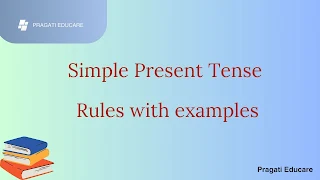Simple present tense rules with examples
Introduction to Simple Present Tense
The Simple Present Tense is one of the most commonly used tenses in English. We use it to talk about actions that are regular, habitual, or true. Understanding the Simple Present Tense is essential for forming correct sentences and communicating effectively in English.
Simple Present Tense નો ઉપયોગ રોજીંદી ક્રિયાઓ (regular), ટેવ (habitual) અથવા સનાતન સત્ય (universal true) વાક્યો માટે થાય છે.
What is Simple Present Tense?
In the Simple Present Tense, we use the base form of the verb. It describes:
1. General Truths : Facts or truths that don’t change.
Example: The sun rises in the east.
સૂર્ય પૂર્વ દિશામાં ઉગે છે.
2. Habits and Routines: Actions that happen regularly.
Example: I brush my teeth every morning.
હું દર સવારે દાંત સાફ કરું છું.
3. Scheduled Events: Fixed schedules or future plans.
Example: The bus leaves at 8 a.m.
બસ 8 વાગ્યે જતી રહે છે.
4. Feelings or Emotions: To express opinions or feelings.
Example: I love chocolates.
મને ચોકલેટ્સ ગમે છે.
Sentence Structure in Simple Present Tense
1. Affiremative Positive Sentences:
Structure: Subject + base verb (+s/es for he, she, it) + object + other words.
Example: He plays cricket. (Positive)
તે ક્રિકેટ રમે છે.
2. Negative Sentences:
Structure: Subject + do/does not + base verb + object + other words.
Example: She does not like tea.
તેને ચા પસંદ નથી.
3. Question Sentences:
Structure: Do/Does + Subject + base verb?
Example: Do you study daily?
શું તમે દરરોજ અભ્યાસ કરો છો?
Rules for Using Simple Present Tense
1. For he, she, it (third-person singular), add ‘s’ or ‘es’ to the base verb.
Example: She writes. (Write + s = writes)
તે લખે છે.
2. Do not add ‘s’ or ‘es’ for I, we, you, they.
Example: I go to school.
હું શાળાએ જાઉં છું.
3. Use ‘do’ and ‘does’ for negative sentences and questions.
“Do” is used with I, we, you, and they.
“Does” is used with he, she, and it.
Common Mistakes in Simple Present Tense and Solutions
1. Adding ‘s’ for plural subjects
Incorrect: They goes to school.
Correct: They go to school.
તેઓ શાળાએ જાય છે.
2. Using ‘does’ instead of ‘do’ with plural subjects
Incorrect: They does not play.
Correct: They do not play.
તેઓ રમતા નથી.
3. Forgetting ‘s’ or ‘es’ for third-person singular
Incorrect: She read books.
Correct: She reads books.
તે પુસ્તકો વાંચે છે.
4. Using Simple Present for ongoing actions
Incorrect: I am playing now.
Correct: I play cricket on Sundays. (Correct use of simple present for habit)
હું રવિવારે ક્રિકેટ રમું છું.
Solution: To avoid these mistakes, remember:
Use ‘s’ or ‘es’ only for singular third-person (he, she, it).
Do not add ‘s’ with plural subjects like ‘they’ or ‘we’.
Examples and Exercises
1. Write 3 sentences about your daily routine.
2. Change these sentences to negative:
She sings well.
They work hard.
FAQ
1. Simple present tense rules with examples
2. Common mistakes in simple present tense
3. How to use simple present tense for students
4. Simple present tense for Gujarati students
5. Simple present tense explanation in English and Gujarati
---
Conclusion
Understanding the Simple Present Tense helps students build a strong foundation in English grammar. By practicing these rules and avoiding common mistakes, students can communicate effectively and confidently.
Simple Present Tense સમજવા માટે આ નિયમો અને સામાન્ય ભૂલોથી બચવા માટે પ્રયત્ન કરો, જેથી તમે તમારા અંગ્રેજી ભાષણમાં યોગ્યતા લાવી શકો.











